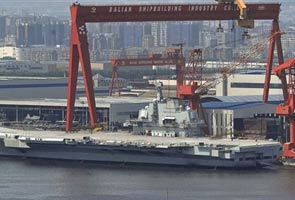
The mission by the refurbished former Soviet carrier marks a first step in readying the craft for full deployment. China says the ship is intended for research and training, pointing to longer-term plans to build up to three additional clones of the carrier in China's own shipyards.
"As a major economy, China should take more responsibilities for the world and on the other hand, it has some new security interests that it needs to protect. Under the circumstances, China's naval power needs to grow accordingly," said Wang Shaopu, director of the Centre for Pan-Pacific Studies at Jiaotong University in Shanghai.
Information about the cruise was tightly restricted in line with the Chinese military's habitual secrecy; although the official Xinhua News Agency indicated that the step had been planned for some time. The 300-foot (91-meter) vessel departed through fog from the northern port of Dalian where it is being overhauled.
"After returning from the sea trial, the aircraft carrier will continue refit and test work," Xinhua said.
China has spent the better part of a decade refurbishing the carrier formerly known as the Varyag after it was towed from Ukraine in 1998, minus its engines, weaponry, and navigation systems.
Beijing's carrier program is seen as the natural outgrowth of the country's burgeoning military expansion, fed by two decades of near-continuous, double-digit percentage increases in the defense budget. China's announced military spending rose to $91.5 billion last year, the second highest in the world after the United States.
China's naval ambitions have been brought into focus with its claims to disputed territory surrounding Taiwan and in the South China Sea.
Over the past year, China has seen a flare-up in spats with Japan, the Philippines and Vietnam and had its relations strained with South Korea - all of which have sought support from Washington, long the pre-eminent naval power in Asia.
China defends its carrier program by saying it is the only permanent member of the United Nations Security Council that has not developed such platforms and that it has a huge coastline and vast maritime assets to defend.
As the world's second largest economy, Beijing says it lags behind smaller nations such as Thailand and Brazil, as well as regional rival India, which have purchased carriers from abroad.
While Chinese carriers could challenge U.S. naval supremacy in Asia, China still has far to go in bringing such systems into play, experts said. The U.S. operates 11 aircraft carrier battle groups and has been shifting naval assets to the Pacific.
Wednesday's exercise was essentially a test of the ship's propulsion system, with preparations to launch and recover aircraft still a long way off, said Andrei Chang, editor of Kanwa Asian Defense magazine.
"This was really just for show. They still have a long way to go," Chang said.
The Xinhua report did not say how long the sea trial would last. But a statement posted on the website of the Liaoning Maritime Safety Authority said vessels will be barred from entering a small section of the sea off Dalian until 6 p.m on Sunday.
Positioning a carrier off its coast would boost the range of China's naval aircraft, increasing their ability to hit U.S. bases in Japan, South Korea, and possibly Guam.
Beijing is believed to be developing a carrier version of the Russian Su-33, dubbed the J-15, a step that has angered defense officials in Moscow who accuse China or stealing their defense technology.
No comments:
Post a Comment